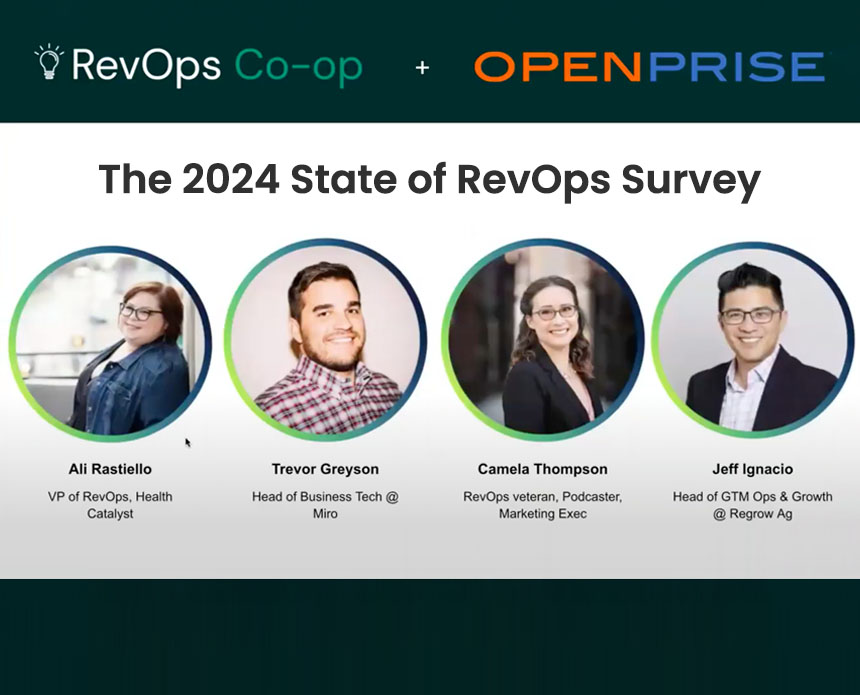
Webinar Spotlight: How operationally mature are you? (And how to improve)
The journey toward operational maturity in RevOps is a difficult path, marked with obstacles and hazards along the way. In our recent webinar with RevOps Co-op, industry experts Ali Rastiello, Trevor Greyson, Camela Thompson, and Jeff Ignacio discussed findings from The 2024 State of RevOps Survey and shared leading best practices that organizations can adopt to achieve operational maturity. Watch the webinar, How Operationally Mature Are You? (And How To Improve), on demand.
Topic: Defining operational maturity
Operational maturity is measured by the varying levels of efficiency and effectiveness across departments, processes, technology, and people in revenue operations. Simply put, it’s how well companies can generate revenue, adapt to market changes, and manage their data to achieve their goals.
The Openprise survey, fielded in partnership with RevOps Co-op and MarketingOps.com, measured operational maturity on three core pillars:
- Go-to-market alignment – how aligned different teams are on KPIs, metrics, and goals
- Data management – how clean data is and how seamlessly automation are integrated
- RevTech stack – how accurately data is reflected across platforms in real-time
Industry aspects like ever-evolving technology, changes in product offerings, or shifting market focus often impact an organization’s ability to reach operational maturity.
Topic: So, how mature are respondents’ organizations on average?
Survey results show organizations skewed less mature, even in organizations with formal RevOps structures. One theory behind the lack of maturity is that RevOps is inconsistently defined. About 42% of survey respondents reported to their CROs, while others responded that they report to CMOs, COOs, or CFOs.
CROs typically own sales, marketing, and customer expansion, but ownership varies in every organization. Other theories include shifting challenges as companies mature or lack control stemming from not selling RevOps’ value proposition well. Some organizations view RevOps as support in go-to-market strategies, but not leaders in defining strategy, which results in friction.
To reach maturity, RevOps needs to influence decisions in alignment with the company mission, values, and goals. As organizations mature, RevOps garner more real estate across departments requiring consistent communication regarding their role’s goals and mission.
Topic: Operational maturity improvement strategies
Go-to-market alignment
- Use generative AI – Organizations can use AI to identify bottlenecks in handoffs or inactive leads and then develop automated processes to save time and money. Learning enrichment and process optimization help companies scale faster, especially in smaller organizations.
- Listen and stay involved – Don’t get stuck in textbook processes. Joining in on SDR calls or demos can reveal better strategies to share with the whole team, improving efficiency. Organize a board of operationally minded individuals from different teams who will provide unique viewpoints to provide a greater overview of company operations.
- Actively document and share processes – Write down and share new processes, like an interview business map, to save growing teams valuable time. A conversation map can save teams two to three hours a week on calls. Teams can use the extra time to prioritize other business-critical initiatives.
Data management
- Understand relational databases inside and out – Marry data points together to ensure everyone speaks the same data language. Ask business-savvy analytics engineers to review your product’s data to ensure it’s the same as it’s presented to customers by your CSMs.
- Keep narratives consistent – QA your calculations to avoid potential embarrassment when reporting to stakeholders. Not only will you understand your calculations, but you’ll also be better able to communicate clearly what they mean to stakeholders and reduce reporting errors.
RevTech
- Unlock the right capabilities – Enrichment tools aren’t perfect. It takes a combination of three to even get close to obtaining good data. Leverage different enrichment tools’ strengths to maximize outputs to improve your pipeline, increase sales, and engage the right people.
- Think before implementing – Know your processes so you don’t blindly insert technology that can’t fix a faulty process. Think holistically about how RevTech impacts not just your work but the work of your whole organization. What may work for you may negatively impact the work of your colleagues.
More expert strategies and peer industry insights
Watch the webinar on-demand to uncover more insights shared by this expert panel. Then, read more about the key challenges and trends your industry peers face with operational maturity in our 2024 State of RevOps Survey.
Recommended Resources















Leave a comment